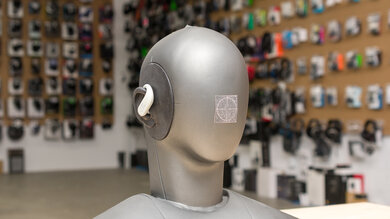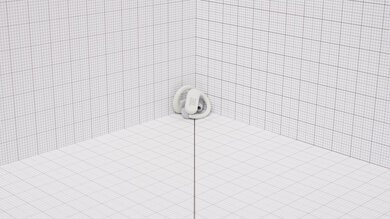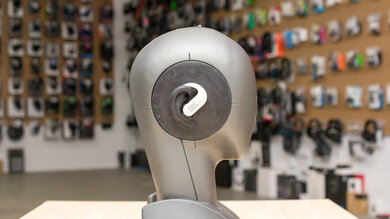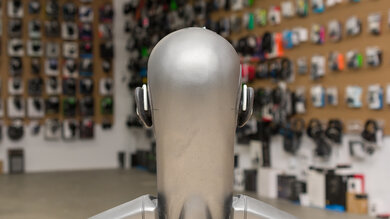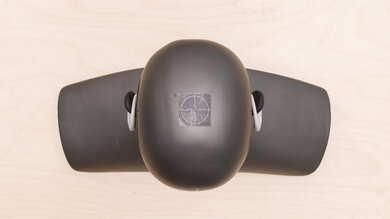The JBL Endurance Peak 3 True Wireless are sports-oriented buds and are the next generation of the JBL Endurance Peak II True Wireless. Although their ear hook design hasn't changed much, they have an increased IP68 rating for dust and water resistance. Unlike their predecessor, they also have companion app support for customizing the buds to your liking, which is good if you find their very bass-heavy sound profile overwhelming.
Our Verdict
The JBL Endurance Peak 3 aren't designed for neutral sound. They're sports-oriented in-ears that utilize JBL's 'Pure Bass Sound,' which is a sound profile with extremely heavy rumble, punch, and boom and will overwhelm the rest of your mix. Like most earbuds, they don't have a very wide or spacious soundstage to help immerse you in your audio. On the upside, their companion app offers a graphic EQ and presets to help you adjust their sound to suit your tastes.
- Customizable sound via companion app.
- Bad passive soundstage due to in-ear design.
The JBL Endurance Peak 3 are good for commute and travel. They have a sturdy ear hook design, which helps keep them in place when you're running to catch the train. That said, the hooks can put pressure on the back of your ears, especially if you wear them for a while, and since they don't have active noise cancelling (ANC), they struggle to block out the low rumble of bus and plane engines. On the upside, they have a long continuous playback time, and their carrying case holds three extra charges for when you need extra power.
- Stable ear hook design.
- Great battery performance.
- Struggle to block out engine noise.
The JBL Endurance Peak 3 are great for sports and fitness. These buds have a well-built and sturdy design, with ear hooks that ensure they won't fall out of place during workouts. They're certified IP68, meaning they're dust-tight, and you can submerge them in water without them taking damage. That said, their fit isn't comfortable for everyone, especially as the ear hooks can put pressure on your ears over time.
- IP68 rating.
- Stable ear hook design.
- Great battery performance.
- Bad passive soundstage due to in-ear design.
The JBL Endurance Peak 3 are okay for office use. These buds have a sporty design with ear hooks, which can put pressure on your ears over time. They also don't support multi-device pairing, so you'll have to re-pair them if you switch from your phone to your computer throughout the day. On the upside, their battery will easily last through a 9 to 5 workday, and they passively isolate you from ambient chatter.
- Great battery performance.
- Good noise handling performance.
- Poor recording quality.
- No multi-device pairing.
The JBL Endurance Peak 3 are Bluetooth earbuds, meaning they can't connect with most consoles. They also have high latency with PCs, which causes your audio and video to fall out of sync. Their low latency mode can help lower latency with iOS devices, which is helpful for mobile gaming, but it's still somewhat high for gaming.
The JBL Peak 3 are Bluetooth-only headphones, and you can't use them wired.
The JBL Endurance Peak 3 are mediocre for phone calls. They have an integrated mic and a hard time capturing your voice clearly. As a result, speech sounds dark, unnatural, and lacks body. On the upside, it does a better job of separating your voice from ambient noise, so you'll still be heard from a noisy place like a busy street. The buds can also reduce a decent amount of sound around you, but they don't have ANC and perform worse with traffic than ambient chatter.
- Good noise handling performance.
- Poor recording quality.
Check Price
Differences Between Sizes And Variants
The JBL Endurance Peak 3 come in four color variants: 'White,' 'Black,' 'Orange,' and 'Blue.' We tested the 'White' variant, and you can see our model's label here. If you encounter another variant of these buds, please let us know in the forums, and we'll update our review.
Popular Headphones Comparisons
The JBL Endurance Peak 3 are the third generation of the JBL Endurance Peak True Wireless, which are sports earbuds. In this generation, the buds have increased water resistance, a better battery life, and even companion app support, giving them a leg over their predecessors. That said, their ear hook design, while stable, isn't as comfortable as similarly designed competitors like the Beats Powerbeats Pro Truly Wireless and the Skullcandy Push Active True Wireless. They also have an extremely bass-heavy sound profile, which is a bit of a departure from other JBL headphones, which tend to follow the Harman target curve more closely and sound more balanced and neutral.
Check out our recommendations for the best headphones for running, the best wireless earbuds for running and working out, and the best earbuds for bass.
The Skullcandy Push Active True Wireless and the JBL Endurance Peak 3 True Wireless have different strengths and, depending on your usage, you may prefer either one. While both headphones have a stable ear-hook design, the Skullcandy are more comfortable, have a more neutral sound profile out of the box, which some people may prefer, and have smart commands via the companion app. However, the JBL are better built and have a better overall battery performance.
The Beats Powerbeats Pro Truly Wireless and the JBL Endurance Peak 3 True Wireless have different strengths and, depending on your preferences, you may enjoy either pair. The Beats are worth considering if you're already in the Apple ecosystem since they have an H1 chip for seamless pairing with iOS devices. They're also significantly more comfortable and have a more neutral sound profile, which some users may prefer. However, the JBL are better built with a higher IP rating for water resistance. They have a better overall battery performance, and their sound can be customized to your liking using their companion app's graphic EQ and presets.
The JBL Endurance Peak 3 True Wireless are better sports earbuds for most people than the Beats Fit Pro True Wireless. The JBL offer a very bass-heavy default sound profile, which is great if you like a lot of extra rumble and punch in your audio. Their sound is also customizable with an in-app graphic EQ and presets. They have a much longer, 10-hour continuous battery life. On the other hand, the Beats have a more neutral default sound profile, which you might prefer for genres like pop or vocal-centric content like podcasts. They have features for Apple users, like an H1 chip for easy pairing and Spatial Audio for a more immersive sound with iOS devices.
The JBL Endurance Peak 3 True Wireless is the next generation of the JBL Endurance Peak II True Wireless. While both models look similar, the successor have a couple of improvements. The third-gen are better built and have a higher IP rating for water resistance, and their battery life is better. They have companion app support, meaning you can adjust their sound to your liking. However, the second-gen have a more neutral sound profile, which some people will prefer, and they can block out more background noise.
Test Results

The JBL Endurance Peak 3 look similar to their predecessor, the JBL Endurance Peak II True Wireless. They have chunky ear hooks, which you might like if stability is a priority. The manufacturer's logo is embossed on the side of the buds, and they come in four color variants: 'Black,' 'White,' 'Blue,' and 'Orange.'
They're fairly comfortable for most people. They don't have a deep in-ear fit, so they don't create a plunger-like feeling. They come with three different pairs of ear tips to help you get the best fit possible. Their ear hooks have 'TwistLock,' which refers to how they are fitted as you twist them backward to secure the hooks over your ears. However, the hooks can put pressure on the back of your ears, especially if you wear glasses. If you have smaller ears, you can accidentally turn the buds off when tightening their fit, which can be annoying. If you want more comfortable ear hook headphones, try the Beats Powerbeats Pro Truly Wireless or the Skullcandy Push Active True Wireless instead.
The JBL Endurance Peak 3 have basic controls. Unlike their predecessor, their touch-sensitive controls are split between the L/R buds. The controls are responsive, and feedback is given when registering commands. There's even voice feedback when turning the ambient sound mode on and off. However, they lack volume controls. You can remap the controls in the app to add a volume function, but you'll lose some of the default controls that way.
On the left earbud:
- Single tap: Enables 'Ambient Aware,' which allows you to stay aware of your surroundings without taking off the earbuds.
- Double tap: Enables 'TalkThru,' which lowers the volume of your audio so that you can have a conversation without removing your earbuds. It also answers and ends calls.
- Tap and hold: Activates voice assistant. If you're on a call, this command mutes and unmutes your mic.
On the right earbud:
- Single tap: Plays and pauses audio.
- Double tap: Skips the track forward. It also answers and ends calls.
- Triple tap: Skips to the previous track.
- Tap and hold: Activates voice assistant. If you're on a call, this command mutes and unmutes your mic.
Because of their bulky ear hooks, they're bigger than conventional truly wireless buds but are still pretty portable. They can easily fit into most bags or pockets without an issue. They also come with a carrying case to help protect them when you're on the go.
Like the earbuds, the case is a bit bigger than other earbuds'. A strip of four LED lights is in the front of the case to indicate battery life. Unlike the buds, the case has no IP rating for dust or water resistance.
They have a great build quality. Although they're made of plastic and silicone material similar to their predecessor, they feel a step up from the JBL Endurance Peak II True Wireless. Their IP rating has gone from IPX7 to IP68 to indicate they're dust-tight and can survive submersion in water. While the silicone ear tips feel like they could rip over time, they're still sturdy enough to survive tough workouts or accidental impacts without taking damage.
The JBL Endurance Peak 3 have a very bass-heavy sound profile. If you enjoy genres like electronica and hip-hop, their intense thump, rumble, and boom can help keep you pumped up at the gym. The rest of the response is fairly flat, but the extra bass still overwhelms voices and instruments. If you prefer a different sound, their companion app offers a graphic EQ and presets to help you get the most out of your buds.
These buds have outstanding frequency response consistency. Once you achieve a good fit using the included ear tips, you'll get consistent bass and treble delivery each time you use them.
The JBL Endurance Peak 3 deliver a lot of extra bass, which is handy if you're a basshead. Their visceral thump and rumble and intense punch and boom is great if you love songs with a prominent bassline, like Radioactive by Imagine Dragons. However, this amount of bass also muddies the rest of the mix and isn't ideal if you prefer a neutral, accurate sound.
The mid accuracy is excellent. The response is fairly flat. Vocals and instruments are detailed and clear, but a dip in the mid-mid nudges them to the back of the mix. In isolation, the mid-range is quite suitable for vocal-centric content. However, the extra bass muddies the entire mix, including the mid-range.
The treble accuracy is also excellent. Vocals and instruments are adequately detailed, while sibilants like S and T are bright and present. If you're listening to bass-heavy tracks, the treble has some trouble cutting through the boom. For example, hi-hats in the song Satisfaction by Benny Benassi are meant to emphasize the lead and bassline but feel weak compared to the extra rumble and boom.
They have a good peaks and dips performance, meaning they follow their own sound profile well. There are a few relatively small deviations across the range: a small bump in the low treble adds extra thump and rumble into mixes. A dip starting in the low-mid extends into the mid-mid, thinning out vocals and instruments and pushing them to the back of the mix. Small peaks in the low treble accentuate the details of vocals and instruments, but the sharp spike in the mid-treble makes sibilants like cymbals piercing.
They have excellent imaging performance. Many of JBL's headphones have good imaging performances, although there have been mismatch issues with their other products in the past, like the JBL Tune 130NC TWS Truly Wireless, which can indicate JBL's larger quality control and ergonomics. That said, our unit's L/R drivers are well-matched. The group delay falls below the audibility threshold, resulting in tight bass and transparent treble reproduction. The drivers are also evenly balanced in amplitude, frequency, and phase response, which ensures the accurate placement of objects like voices within the stereo image. However, imaging varies between units, so you might have a different experience.
They don't have a good passive soundstage, which is normal for in-ear headphones, which bypass your outer ear by design. This soundstage is perceived as small and as if coming from the inside of your head rather than from speakers in the room around you. Since they also have a closed-back design, their soundstage doesn't feel very spacious or open, either.
These headphones have a great weighted harmonic distortion performance. Although there's a small peak in between the low- to mid-treble, it's very minor. Most frequencies fall within acceptable limits, resulting in clean and pure audio reproduction.
These are the settings used to test the JBL Peak 3. Our results are only valid when used in this configuration.
They have a decent noise isolation performance. They don't have an active noise cancelling system, so they don't block out much of the low rumble of bus and plane engines. That said, they do a good job of passively reducing mid- to high-pitched sounds, so they can help cut down on ambient chatter or a humming A/C unit at the gym.
The leakage performance is outstanding. Leakage is mostly concentrated in the bass and treble range. However, the leakage is low, so even if you're listening to audio at high volumes, others around you won't hear it.
The integrated mic has poor recording quality. Recorded speech sounds dark and unnatural and lacks depth.
The mic has a good noise-handling performance. It can separate your voice from moderate noise fairly well, but your voice can get temporarily drowned out by very loud sounds, like a train pulling up to the station. However, if you're taking a call from a consistently noisy place like a busy street, you'll have no problems being understood clearly.
The JBL Endurance Peak 3 have great battery performance. The manufacturer advertises them to last 10 hours continuously, and we measured a similar amount. Battery life varies depending on use, though. Their carrying case also holds an extra three charges. They also have a quick charge feature, which the manufacturer advertises to provide one hour of playback from 10 minutes of charging. There's an auto-off timer to conserve battery life when not in use.
Unlike the JBL Endurance Peak II True Wireless, these buds are compatible with the JBL Headphones app. You can see a video of how it works here. You don't need an account to use the app. You can access a 10-band EQ and presets, turn on/off or cycle between ambient mode controls, and remap controls. You can also adjust the voice assistant and voice prompts as well as access dedicated audio and video modes to help improve audio quality and lower audio lag, respectively.
Their Bluetooth connectivity is okay. On the one hand, they don't support multi-device pairing and have high latency across all devices with the default codec, which isn't great for streaming video. On the flip side, they have a smart video mode in their companion app, which is meant to help lower latency. It lowers latency with iOS devices to within good levels, so you can watch a video on your iPhone without audio syncing issues. However, latency with Android still falls just outside of good levels, and PC latency is still high, so your audio and video will likely be out of sync if you use them to watch a movie on your computer or play a mobile game with your Android phone. That said, some devices and apps compensate for latency.
The JBL Endurance Peak 3 can connect to Bluetooth-enabled PCs with full audio and mic support. However, this is the only way to connect these headphones to your PC.

